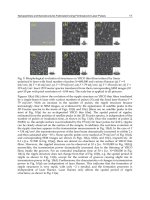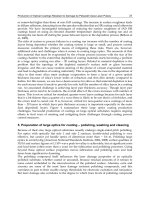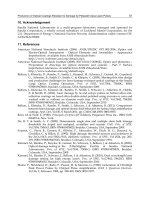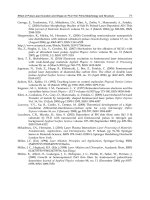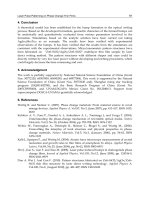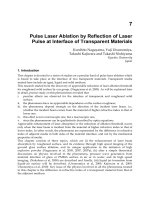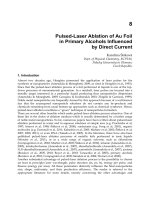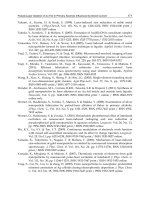Lasers Applications in Science and Industry Part 12 pptx
Bạn đang xem bản rút gọn của tài liệu. Xem và tải ngay bản đầy đủ của tài liệu tại đây (3.28 MB, 20 trang )
Laser Pulse Application in IVF
211
nuclear transfer and of blind enucleation in zona-free bovine cloning. Cloning and
Stem Cells, Vol .11, No. 2, pp. 287-92.
Malter, H., & J. Cohen. (1989) Partial zona dissection of the human oocyte: a non traumatic
method using micromanipulation to assist zona pellucida penetration. Fertility and
Sterility, Vol. 51, No. 1, pp. 139-48.
Mantoudis E., Podsiadly BT., Gorgy A., Venkat, G., & I. Craft. (2001) A comparison between
quarter partial and total laser assisted hatching in selected infertility patients.
Human Reproduction, Vol. 16, No. 10, pp. 2182-86.
Montag, M., van der Ven, K., Delacretax, G., Rink, K., & H. van der Ven. (1998) Laser-
assisted microdissection of the zona pellucid facilitates polar body biopsy. Fertility
and Sterility, Vol. 69, No. 3, pp. 539-42.
Montag, M., Rink, K., Dieckmann, U., Delacretax, G., & H. van der Ven. (1999) Laser-
assisted cryopreservation of single human spermatozoa in cell-free zona pellucida.
Andrologia, Vol. 31, pp. 49-53.
Montag, M., Koll, B., Holmes, P., et al. (2000a) Significance of the number of embryonic cells
and the state of the zona pellucida for hatching of mouse blastocysts in vitro versus
in vivo. Biology of Reproduction, Vol. 62, pp. 1738-44.
Montag, M., Koll, B., & H. van der Ven. (2000b) Use of a laser to evaluate zona pellucida
hardness at different stages of mouse embryonic development in vitro and in vivo.
Journal of Assisted Reproduction and Genetics, Vol. 17, No. 3, pp. 78-81.
Montag, M., Lemola, R., & H. van der Ven. (2000c) A new method to produce equally sized
hemizonae pellucidae for the hemizona assay. Andrologia, Vol. 32, pp. 179-80.
Montag, M., Rink, K., Delcretaz, G., & H. van der Ven. (2000d) Laser-induced
immobilization and plasma membrane permeabilization in human spermatozoa.
Human Reproduction, Vol. 15, No. 4, pp. 846-52.
Montag, M., van der Ven, K., Dorn C., & H. van der Ven. (2004) Outcome of laser-assisted
polar body biopsy and aneuploidy testing. Reproductive BioMedicine Online, Vol. 9,
No. 4, pp. 425-29.
Montag M., Klose R., Koster M., Rosing, B., van der Ven, K., Rink, K., & H. van der Ven.
(2009) Application of non-contact laser technology in assisted reproduction.
Medical Laser Application, Vol. 24, pp. 57-64.
Moser M., Ebner T., Sommergruber M., Gaisswinkler, U., Jesacher, K., Puchner, M.,
Wiesinger, R., & G. Tews. (2004) Laser-assisted zona pellucida thinning prior to
routine ICSI. Human Reproduction, Vol. 19, No. 3, pp. 573-78.
Mukaida, T., Oka, C., Goto, T., & K. Takahashi. (2006) Artificial shrinkage of blastocoeles
using either a micro-needle or a laser pulse prior to the cooling steps of vitrification
improves survival rate and pregnancy outcome of vitrified human blastocysts.
Human Reproduction, Vol. 21, No. 12, pp. 3246-52.
Nagy, Z., Oliveira, A., Abdelmassih, & R. Abdelmassih. (2001) Novel use of laser to assist
ICSI for patients with fragile oocytes: a case report. Reproductive BioMedicine Online,
Vol. 4, No. 1, pp. 27-31.
Neev J., Tadir Y., Ho P., Berns, M., Asch, R., & T. Ord. (1992) Microscope-delivered
ultraviolet laser zona dissection: principles and practices. Journal of Assisted
Reproduction and Genetics, Vol. 9, No. 6, pp. 513-23.
Nijs, M., Vanderzwalmen, P., Vandamme, B., Segal-Bertin, G., Lejeune, B., Segal, L., van
Roosendaal, E., & R. Schoysman. (1996) Fertilizing ability of immotile spermatozoa
Lasers – Applications in Science and Industry
212
after intracytoplasmic sperm injection. Human Reproduction, Vol. 11, No. 10, pp.
2180-85.
Obruca, A., Strohmer, H., Blaschitz, A., Schonickle, E., Dohr, G., & W. Feichtinger. (1997)
Ultrastructural observations in human oocytes and preimplantation embryos after
zona opening using an erbium-yttrium aluminium-garnet (Er:YAG) laser. Human
Reproduction, Vol. 12, No. 10, pp. 2242-45.
Palanker, D., Ohad, O., Lewis, A., Simon, A., Shenkar, J., Penchas, S., & N. Laufer. (1991)
Technique for cellular microsurgery using the 193 nm excimer laser. Lasers in
Surgery and Medicine, Vol. 11, pp. 580-86.
Palermo, G., Joris, H., Devroey, P., & A. van Streirteghem. (1992) Pregnancies after
intracytoplasmic injection of a single spermatozoon into an oocyte. Lancet, Vol. 340,
p. 17.
Palermo, G., Alikani, M., Bertoli, M., Colombero, T., Moy, F., Cohen, J., & Z. Rosenwaks.
(1996) Oolemma characteristics in relation to survival and fertilization patterns of
oocytes treated by intracytoplasmic sperm injection. Human Reproduction, Vol. 11,
No. 1, pp. 172-76.
Peters, D., Kepikhov, K., Rodenacker, K., Marschall, S., Boersma, A., Hutzler, P., Scherb, H.,
Walter, J., & M. Harabe de Angelis. (2009) Effect of IVF and laser zona dissection
on DNA methylation pattern of mouse zygotes. Mammalian Genome, Vol. 20, pp.
664-73.
Raabe, I., Vogel S., Peychl, J., I. Tolic-Norrelykke. (2009) Intracellular nanosurgery and cell
enucleation using a picoseconds laser. Journal of Microscopy, Vol. 234, pp. 1-8.
Rakityansky, M., Agranat, M., Ashitkov, S., Ovchinnikov, A., Semenova, M., Sergeec, S.,
Sitnikov, D., & I. Shevelev. (2011) Cell technology employing femtosecond laser
pulses. Cell Technologies in Biology and Medicine, Vol. 1, pp. 54-56.
Rienzi, L., Greco, E., Filippo, U., Iacobelli, M., Martinez, F., & J. Tesarik. (2001) Laser-
assisted intracytoplasmic sperm injection. Fertility and Sterility, Vol. 76, No. 5, pp.
1045-47.
Rienzi, L., Nagy, ZP., Ubaldi, F., Iacobelli, M., Anniballo, R., Tesarik, J., & E. Greco. (2002)
Laser-assisted removal of necrotic blastomeres from cryopreserved embryos that
were partially damaged. Fertility and Sterility, Vol. 77, No. 6, pp. 1196-1201.
Rienzi, L., Ubaldi, F., Martinez, F., Minasi, M., Iacobelli, M., Ferrero, S., Tesarik, J., & E.
Grego. (2004) Clinical application of laser-assisted ICSI: a pilot study. European
Journal of Obstetrics and Gynecology, Vol. 115S, pp. S77-79.
Rink, K., Delacretaz, G., Salathe R., Senn, A., Nocera, D., Germond, M., de Grandi, P, & S.
Fakan. (1996) Non-contact microdrilling of mouse zona pellucida with an
objective-delivered 1.48 um diode laser. Lasers in Surgery and Medicine, Vol. 18, pp.
52-62.
Sagoskin, A., Levy, M., Tucker, M., Richter, K., & E. Widra. (2007) Laser assisted hatching in
good prognosis patients undergoing in vitro fertilization-embryo transfer: a
randomized controlled trial. Fertility and Sterility, Vol. 87, No. 2, pp. 283-87.
Sathananthan, H., Menezes, J., & S. Gunasheela. (2003) Mechanics of human blastocyst
hatching in vitro. Reproductive BioMedicine Online. Vol 7, No. 2, pp. 228-34.
Schopper, B., Ludwig, M., Edenfeld, J., Al-Hasani, S., & K. Diedrich. (1999) Possible
applications of lasers in assisted reproductive technologies. Human Reproduction,
Vol. 14, pp. 186-93.
Laser Pulse Application in IVF
213
Schutze, K., Clement-Sengewald, A., & A. Ashkin. (1994) Zona drilling and sperm insertion
with combined laser microbeam and optical tweezers. Fertility and Sterility, Vol. 61,
No. 4, pp. 783-86.
Schutze, K., & G. Lahr. (1998) Identification of expressed genes by laser-mediated
manipulation of single cells. Nature Biotechnology, Vol. 16, pp. 737-42.
Tadir, Y., Wright, W., Vafa, O., Ord, T., Asch, R., & M. Berns. (1989) Micromanipulation of
sperm by a laser generated optical trap. Fertility and Sterility,Vol. 52, No. 5, pp. 870-
73.
Tadir, Y., Wright, W., Vafa, O., Ord, T., Asch, R., & M. Berns. (1990) Force generated by
human sperm correlated to velocity and determined using a laser generated optical
trap. Fertility and Sterility, Vol. 53, No. 5, pp. 944-47.
Tadir, Y., Wright, W., Vafa, O., Liaw, L., Asch, R., & M. Berns. (1991) Micromanipulation of
gametes using laser microbeams. Human Reproduction, Vol. 6, No. 7, pp. 1011-16.
Tanaka, N., Takeuchi, T., Neri, Q., Sills, E., & G. Palermo. (2006) Laser-assisted blastocyst
dissection and subsequent cultivation of embryonic stem cells in a serum/cell free
culture system: applications and preliminary results in a murine model. Journal of
Translational Medicine, Vol. 4, pp. 20-32.
Taylor, T., Gilchrist, J., Hallowell, S., Hanshew, K., Orris, J., Glassner, M. & J. Wininger.
(2010) The effects of different laser pulse lengths on the embryo biopsy procedure
and embryo development to the blastocyst stage. Journal of Assisted Reproductive
Genetics, Vol. 27, pp. 663-67.
Tinney, G., Windt, M., Kruger T., & C. Lombard. (2005) Use of a zona laser treatment
system in assisted hatching: optimal laser utilization parameters. Fertility and
Sterility, Vol. 84, No. 6, pp. 1737-41.
Tsai, M., Huang, F., Kung, F., Lin, Y., Chang, S., Wu, J., & H. Chang. (2000) Influence of
polyvinylpyrrolidone on the outcome of intracytoplasmic sperm injection. Journal of
Reproductive Medicine, Vol. 45, No. 2, pp.115-20.
Tucker, M., & G. Ball. (2009) Assisted hatching as a technique for use in human in vitro
fertilization and embryo transfer is long overdue for careful and appropriate study.
Journal of Clinical Embryology, Vol. 12, No. 1, pp. 10-14.
Turketsky, T., Aizenman, E., Gil, Y., Weinberg, N., Shufaro, Y., Revel, A., Laufer, N., Simon,
A., Abeliovich, D., & B. Reubinoff. (2008) Laser-assisted derivation of human
embryonic stem cell lines from IVF embryos after preimplantation genetic
diagnosis. Human Reproduction, Vol. 23, No. 1, pp. 46-53.
Vanderzwalmen, P., Bertin, G., Lejeune, B., Nijs, M., Vandamme, B., & R. Schoyman. (1996)
Two essential steps for a successful intracytoplasmic sperm injection: injection of
immobilized spermatozoa after rupture of the oolemma. Human Reproduction, Vol.
11, No. 3, pp. 540-47.
Vanderzwalmen, P., Bertin, G., Debauche, C., Standaert, V., van Roosendaal, E.,
Vandervorst, M., Bollen, N., Zech, H., Mukaida, T., Takahashi, D., & R. Schoysman.
(2002) Births after vitrification at morula and blastocyst stages: effect of artificial
reduction of the blastocoelic cavity before vitrification. Human Reproduction, Vol. 17,
No. 3, pp. 744-51.
Vela, G., Luna, M., Sandler, B., & A Copperman. (2009) Advances and controversies in
assisted reproductive technology. Mount Sinai Journal of Medicine, Vol. 76, pp. 506-
20.
Lasers – Applications in Science and Industry
214
Verlinsky, Y., Ginsberg, N., Lifchez, A., Valle, J., Moise, J., & C. Strom. (1990) Analysis of the
first polar body: preconception genetic diagnosis. Human Reproduction, Vol. 5, No.
7, pp. 826-29.
Wong, B., Boyd CA., Lanzendorf SE. (2003) Randomized controlled study of human zona
pellucida dissection using the Zona Infrared Laser Optical System: evaluation of
blastomere damage, embryo development, and subsequent hatching. Fertility and
Sterility, Vol. 80, No. 5, pp. 1249-54.
Yanagida, K., Katayose, H., Hirata, S., Hayashi, S., & A. Sato. (2001) Influence of sperm
immobilization on onset of Ca
+2
oscillations after ICSI. Human Reproduction, Vol. 16,
No. 1, pp. 148-52.
11
Dynamic Analysis of Laser Ablation
of Biological Tissue by Optical
Coherence Tomography
Masato Ohmi and Masamitsu Haruna
Course of Health Science, Graduate School of Medicine
Osaka University
Japan
1. Introduction
Laser ablation is widely used in optical material engineering but also in clinical medicine.
Actually, it has been used for evaporation and cutting of biological tissue in surgical
operations; for example, the refractive surgery of cornea (Trokel et al. 1983; Puliafito et al.
1985) and the surgery of vascular (Isner et al. 1987). In particular, various types of CW and
pulsed lasers have been considered for removal of hard dental tissues. Laser ablation may
potentially provide an effective method for removal of caries and hard dental tissues with
minimal thermal and mechanical damage to surrounding tissue. An important issue is
quantitatively determining the dependence of tooth ablation efficiency or the ablation rate
on the laser parameters such as repetition rate and energy of laser pulses. Up to now, the
measurement has been made by observation of the cross section of the tissue surface, using
a microscope or SEM, after cutting and polishing of a tissue sample (Esenaliev et al. 1996).
This sort of process is cumbersome and destructive. On the other hand, shape of the tissue
surface may change gradually with time after irradiation of laser pulses. The deformation of
tissue surface is due to dehydration. The surrounding tissue may also suffer serious damage
from laser ablation if the laser fluence is too high. Therefore, in-situ observation of the cross
section of tissue surface is strongly required.
A very promising candidate for such an in-situ observation is the so-called optical coherence
tomography (OCT) (Huang et al. 1991). The OCT is a medical diagnostic imaging technology
that permits in-situ, micron-scale, tomographic cross-sectional imaging of microstructures in
biological tissues (Hee et al. 1995; Izatt et al. 1996; Brezinski et al. 1996). At present, in the
practical OCT, a super luminescent diode (SLD) is used as the light source for the low-
coherence interferometer, providing the spatial resolution of 10 to 20 m along the depth.
Therefore, the OCT is potential for monitoring of the surface change during tissue ablation
with micrometer resolution. Boppart et al have first demonstrated OCT imaging for
observation of ex vivo rat organ tissue (Boppart et al. 1999). Alfrado et al have demonstrated
thermal and mechanical damage to dentin by sub-microsecond pulsed IR lasers using OCT
imaging (Alfano et al. 2004). We have also demonstrated an effective method for the in situ
observation of laser ablation of biological tissues based on OCT (Haruna et al. 2001; Ohmi et
Lasers – Applications in Science and Industry
216
al. 2005; Ohmi et al. 2007). In the traditional OCT system using a super-luminescent diode as
a light source, imaging speed is limited. In fact, our first reported laser-ablation system, a
time-domain OCT (TD-OCT) at the center wavelength of 0.8-m is combined with a laser
ablation system, where the optical axis of OCT is aligned with the 1.06-m Q-switched YAG
laser beam using a dichroic mirror. In this system, the data acquisition of each OCT image
takes four seconds. The tissue laser ablation and the OCT imaging are repeated in turn. In
this system, with this time delay for data acquisition, it is impossible to observe deformation
of a crater and damage to the surrounding tissue due to thermal accumulation effects.
On the other hand, the recent application of Fourier-domain techniques with high-repetition
rate swept laser source to OCT has led to an improvement in sensitivity of several orders of
magnitude, toward high-speed OCT imaging (Yun et al. 2003; de Bore et al. 2003). Recently,
we demonstrated true real-time OCT imaging of tissue laser ablation. A swept source OCT
(SS-OCT) with 25 frames / s is used for the in situ observation, while tissue laser ablation is
made continuously by 10-Hz YAG laser pulses (Ohmi et al. 2010). With this system, dynamic
analysis of laser ablation can be achieved, taking thermal accumulation effects into account.
In this chapter, we summarize overview of in situ observation of biological tissue in laser
ablation using OCT imaging technique. At first, laser ablation system with the time-domain
OCT (TD-OCT) including the experimental data is described. Next, real-time in situ imaging
of tissue ablation using swept source OCT (SS-OCT) is described. Laser ablation of hard and
soft tissues including the ablation rate are demonstrated. Furthermore, the 3-D OCT image
of the crater of biological tissue can be constructed by volume rendering of several hundred
B-mode OCT images.
2. In-situ observation of laser ablation of biological tissue by time-domain
OCT
2.1 System configuration
In order to achieve in-situ tomographic observation of the crater surface just after laser
ablation of biological tissue, the laser-ablation optics and OCT imaging optics are combined.
The system configuration is shown in Fig. 1. In laser ablation of tissue, the Q-switched
Nd:YAG laser is used as the light source, which supplies laser pulses of 10 ns at the
wavelength of 1.06 m with the repetition rate of 10 Hz. The laser pulse is focused on a
tissue sample via an x 10 objective with a 20-mm focal length lens. The focused beam spot
size of 20 m in the focal plane with the length of the beam waist is calculated of 630 m.
The laser pulse energy is typically 6.4 mJ with the energy per unit area of 5.1 x 10
3
J / cm
2
on
the tissue surface.
On the other hand, the OCT system is a time-domain OCT (TD-OCT) which consists of the
optical-fiber interferometer with the fiber-optic PZT phase modulators (Bouma et al. 2002).
The light source is a 1.3-m SLD whose output light of 13mW is coupled into a single-mode
fiber directional coupler. For optical delay scanning, two identical fiber-optic PZT
modulators are places on both reference and signal arms. In each PZT modulators, a nearly
20-m long single-mode fiber was wrapped around a cylindrical piezoelectric transducer.
Two PZT modulators were driven in push-pull operation. The scanning depth along the
optical axis becomes 1.0 mm when a 250-V triangular voltage is applied to two PZTs. In the
sample arm of the interferometer, the collimated light beam of 6 mm diameter is focused on
Dynamic Analysis of Laser Ablation of Biological Tissue by Optical Coherence Tomography
217
a sample via a microscope. Fortunately, it is a common knowledge that zero dispersion of a
silica fiber lies near 1.3 m. A great advantage of the all-optical-fiber OCT of Fig. 1,
therefore, is that the coherence length does not increase significantly even if there is a
remarkable optical path difference between reference and signal arms. In fact, we measured
the coherence length of 19.1 m. This value was very close to the expected value of 18.2 m
from the spectral bandwidth of the SLD itself. This value determines the resolution of OCT
image along the optical axis. On the other hand, the lateral resolution is 5.6 m determined
by the focusing spot size of the x 10 objective used in the experiment. This value determines
the resolution of OCT image along the optical axis.
PZT
PZT
SLD
BPF
A/D
Function
generator
1.3
m
PD
Fiber optic
coupler
2.5V
+250V
-250V
-250V
+250V
PC
Q-switched
Nd:YAG laser
Electronic shutter
Dichroic mirror
Objective
×
10
Stage
controller
CCD
Monitor
Energy
meter
Reference
mirror
=1.06
m
10Hz
Shutter
controller
Sample
15mW
Fig. 1. System configuration of laser ablation with the time-domaion OCT (TD-OCT).
A key point for in-situ observation of the crater surface is that the YAG laser beam is aligned
with the SLD light beam on the sample arm of the interferometer. These two light beams are
combined or divided by a dichroic mirror, and an electronic shutter is placed in front of the
YAG laser. Therefore, both the YAG laser and SLD light illuminate the same point on the
tissue sample. In the experiment, at first, a certain number of YAG laser pulses are irradiated
on the tissue sample, and a crater is formed on the sample surface. The YAG laser beam is
then cut off with the electronic shutter, followed by obtaining an OCT image of the crater.
The OCT imaging takes one second in the case where the image size is 1.0 x 1.0 mm
2
with a
pixel size of 2.5 x 2.5 m
2
. After the OCT imaging, the laser ablation is again started with
Lasers – Applications in Science and Industry
218
irradiation of a certain number of laser pulses. The laser ablation and OCT imaging are
repeated by turn. This process is automatically controlled in our system. The characteristic
of the system performance is summarized in Table 1, where the repletion rate of PZT phase
modulator is 200 Hz at the OCT imaging area of 1 x 1 mm
2
.
2.2 In-situ observation of ablation crater and the evaluation of ablation rate
In the experiment, human tooth enamel was used for the sample of laser ablation. A human
tooth is a suitable representative for a hard tissue sample, because the tooth consists of two
layers, enamel and dentine, and there is a remarkable difference in refractive index and
hardness between these two materials. The interface between enamel and dentine is
therefore recognized clearly in the OCT image. The ablation rate is quite different for enamel
and dentine, as will be discussed later. The crater shape is also different between enamel
and dentine because of the abrupt change in hardness at the interface.The Nd:YAG laser
pulses were focused on the surface of human tooth enamel to make the ablation crater
depending upon the laser-pulse shot number. Figure 2 shows a series of OCT images of
craters of human tooth enamel, where N is the laser-pulse shot number. From these OCT
images, surface change of the ablation crater of the human tooth enamel is clearly observed.
Moreover, showing all of OCT images continuously, time-serial tomographic observation of
the crater in laser ablation is carried out.
N=0
N=400
N=800
N=1200
N=2000
N=1600
N=2400
N=2800
Enamel Dentine
Z
X
Z
X
200
m
Fig. 2. A series of TD-OCT images of craters in laser ablation of human tooth.
Dynamic Analysis of Laser Ablation of Biological Tissue by Optical Coherence Tomography
219
The crater depth is also measured by the raster-scan signal of each OCT image. The
measurement accuracy of the crater depth is 2.5 m, which is determined by a pixel size of
the OCT image. This value is smaller than the coherence length of 19m of the SLD light
source. The measured crater depths are plotted with respect to the laser-pulse shot number
N, as shown in Fig. 3. From the data of N = 0 to 2000, a straight line was determined by the
least squares method. The slope of the straight line yields the ablation rate of 0.11 m /
pulse with a standard deviation of 0.008 m / pulse when the laser pulse energy is 16.0
mJ. Furthermore, from the data of N = 2200 to 2800, a straight line was determined by the
least squares method. The slope of the straight line yields the ablation rate of 0.46 m /
pulse with a standard deviation of 0.015 m / pulse in the human tooth dentine. The
ablation rate of human tooth dentine is almost four times larger than human tooth enamel.
Dentine is somewhat soft tissue rather than human tooth enamel. From the experimental
results described above, one can find that OCT is really useful for monitor of the crater
shape and the ablation rate with the damage of the surrounding tissues.
Laser pulse shot number N
Depth of crater (
m)
3000
2500
20001500
1000
5000
0
100
200
300
400
500
600
Enamel
0.11
m/pulse
Dentine
0.46
m/pulse
Fig. 3. Measurement of ablation rate of human tooth.
3. Real-time imaging of laser ablation of biological tissue by swept-source
OCT
3.1 System configuration
In the former system, with this time delay for data acquisition, it is impossible to observe
deformation of a crater and damage to the surrounding tissue due to thermal accumulation
effects. In order to perform dynamic analysis of laser ablation of biological tissue, a swept-
source OCT (SS-OCT) is combined with a YAG-laser ablation system, as shown in Fig. 4. In
the SS-OCT, the optical source is an extended-cavity semiconductor wavelength-swept laser
Lasers – Applications in Science and Industry
220
employing an intracavity polygon scanner filter (HSL-2000, santec corporation). The lasing
frequency is swept linearly with time, to obtain the reflected light distribution along the
depth of the tissue sample. Fourier transformation of the interference signals results in
reflected light distribution along the tissue depth. The SS-OCT consists of fiber-optic
components, and the illuminating laser beam on the signal arm of the OCT interferometer is
aligned with the YAG laser beam using a dichroic mirror. The light reflected from the
reference mirror and the sample were recieved through magneto-optic circulators and
combined by a 50/50 coupler. A fiber-optic polarization controller in the reference arm and
the sample arm were used to align the polarization states of the two arms. The laser beam is
then scanned with a Galvano mirror, resulting in a clear image of the ablation crater of the
tissue sample. The center wavelength of the swept laser is 1.33 m, with a wavelength
scanning range of 110 nm. The sweep frequency of the laser source is 20 kHz at 25 frames /
s, while the imaging area is 1 x 1 mm
2
with a pixel size of 8 x 5 m. The real-time imaging of
tissue laser ablation is thus realized in a fusion system of YAG-laser ablation and the fiber-
optic SS-OCT. The measured coherence length of the SS-OCT system is 13 m.
An electronic shutter is placed in front of the dichroic mirror to exactly adjust the ablation
time. Both the YAG laser beam and the OCT probing laser beam are focused with the x 10
objective. The focused spot size is adequately adjusted by the laser beam width. In the
experiment, the focused beam spot size is nearly 20 m on the tissue surface. On the other
hand, the focused spot size of the OCT probing beam is 5.6 m, with a focal depth of only 40
m. The out-of-focusing is unavoidable in the resulting OCT images, because there is no
focus tracking mechanism in the present system.
Fiber optic
coupler
PCPC
Q-switched
Nd:YAG laser
Electronic shutter
Dichroic mirror
Objective
×
10
CCD
Monitor
Energy
meter
Reference
mirror
=1.06
m
10Hz
Shutter
controller
Sample
Galvano
mirror
Balance detector
-
+
Galvanometer
driver
Polarization
controller
90%
10%
(50/50)
Function
generator
1.33
m 110nm
20kHz 7mW
Swept laser
source
Fig. 4. System configuration of laser ablation with the swept-source OCT (SS-OCT).
Dynamic Analysis of Laser Ablation of Biological Tissue by Optical Coherence Tomography
221
3.2 Real-time imaging of tissue laser ablation and the evaluation of ablation rate
3.2.1 Hard tissue ablation
In the experiment, the laser pulse energy is typically 15.7 mJ with the energy per unit area
of 5.0 x 10
3
J / cm
2
with a focused beam spot size of 20 m on the tissue surface. The laser
ablation of a human tooth made is continuously by the Q-switched YAG laser. Time-
sequential OCT images of the crater of a human tooth are shown, where N is the shot
number of the illuminating laser pulses, as shown in Fig. 5. The interface between enamel
and dentine is clearly recognized in each OCT image because of the large refractive index
difference between enamel (n = 1.652) and dentine (n = 1.546) (Ohmi et al. 2000). The
crater depth increases gradually in the enamel, and it appears as if the interface between
enamel and dentine juts out into the enamel. Near N = 2400, the YAG laser beam
penetrates into the dentine through the enamel. The crater width becomes abruptly
narrower in the dentine, reflecting the large difference in hardness between enamel and
dentine. In addition, in the real-time imaging shown in Fig. 5, a small flying particle
(debris), is observed in the crater, as indicated by a white circle, although the ablation
plume is not imaged by OCT. The crater depth is measured in each OCT image, obtained
by real-time imaging at 25 frames / s, where d is determined by the raster scan signal
along the center of the crater. All measured values of d are plotted with respect to the shot
number N of laser pulses, as shown in Fig. 6.
N=0
N=400
N=800 N=1200
N=1600 N=2000
N=2400
N=2800
200
m
Debris
Z
X
Z
X
Enamel Dentine
Fig. 5. A series of SS-OCT images of craters in laser ablation of human tooth.
Lasers – Applications in Science and Industry
222
1500 30005000
Laser pulse shot number N
Depth of crater (m)
1000
2000
0
100
200
300
400
Enamel
0.11
m/pulse
2500
500
600
Dentine
0.43
m/pulse
Fig. 6. Measurement of ablation rate of human tooth.
Furthermore, OCT images of craters formed after illuminating laser pulses in enamel and
dentine are shown in Fig. 7 (a), where the input laser fluence was 1.42 x 10
3
J / cm
2
to 6.87 x
10
3
J / cm
2
. The ablation rate versus the input laser fluence for enamel and for dentine is also
shown in Fig. 7 (b). The ablation rate does not increase in linear proportion to the laser
fluence, due to thermal accumulation effects, and it tends to saturate as the fluence
increases. From the OCT image of the crater, the ablation volume of the crater increases
according to the input laser fluence.
It is important to pay attention to the ablation rate and the volume of the crater. The
ablation volume of a crater is evaluated in the following manner. In each frame of time-
sequential OCT images, the crater is cut into 5-m thick disks along the depth, under the
assumption that the crater has a circular cross section. This assumption is consistent with
the actual crater shape found in the 3-Dimensional OCT (3-D OCT) image of a human
tooth, as will be shown later. The diameter is easily measured for each disk in the OCT
image, and the crater volume is then counted by piling up 5-m thick disks along the
depth. All measured values of the ablation volume are plotted with respect to the shot
number N of laser pulses, as shown in Fig. 8. From the slope of the straight line, the
volume ablation rate of enamel and of dentine are obtained to be 1.31 x 10
4
m
3
/ pulse
and 4.90 x 10
4
m
3
/ pulse, respectively. The volume ablation rate versus input laser
fluence for enamel and for dentine is shown in Fig. 9. The volume ablation rate increases
in linear proportion to the input laser fluence.
Dynamic Analysis of Laser Ablation of Biological Tissue by Optical Coherence Tomography
223
1234567
0
0.1
0.2
0.3
0.4
0.5
0.6
0.7
Fluence (J/cm
2
)
(x10
4
)
Ablation rate (
m / pulse)
200
m
Dentine
1
2 3 4
200
m
Enamel
5
6 7 8
(a)
3
4
2
1
Dentine
Enamel
8
7
6
5
(b)
Fig. 7. Ablation rate versus laser fluence. (a) OCT images of the crater of enamel and
dentine. (b) Ablation rate versus laser fluence.
Lasers – Applications in Science and Industry
224
(a)
(b)
(x10
7
)
0 100 200 300 400 500 600 700
0
1.0
2.0
3.0
4.0
5.0
Dentine
Laser pulse shot number (N)
Ablation volume (m
3
)
0 500 1000 1500 2000 2500 3000
0
1.0
2.0
3.0
4.0
5.0
1.31 x 10
4
m
3
/pulse
Enamel
Fluence 6.04 x10
4
J/cm
2
Laser pulse shot number (N)
Ablation volume (m
3
)
(x10
7
)
4.90 x 10
4
m
3
/pulse
Fluence 6.04 x10
4
J/cm
2
Fig. 8. Measured ablation volume versus laser shot number. (a) Enamel, (b) Dentine.
1234567
0
1.0
2.0
3.0
4.0
5.0
6.0
7.0
Volume ablation rate (
m
3
/pulse)
Fluence (J/cm
2
)
(x10
4
)
(x10
4
)
1
2
3
4
5
6
7
8
Dentine
Enamel
Fig. 9. Volume ablation rate versus laser fluence.
3.2.2 Soft tissue ablation
The aorta of a dog was used as an example of a soft tissue. An aorta has a three-layer wall
that consists of the tunica intima, tunica media, and tunica adventitia. In the experiment, the
YAG laser beam is focused on the inner surface of the aorta. In addition, the input laser
fluence is reduced to 6.0 x 10
2
J / cm
2
to avoid the pronounced thermal accumulation effect
Dynamic Analysis of Laser Ablation of Biological Tissue by Optical Coherence Tomography
225
that occurs in soft tissue ablation. Time-sequential OCT images of the dog aorta are shown,
where the shot number N of laser pulses is 0 to 50, as shown in Fig. 10. In particular, thermal
deformation of the crater is found where upheaval and removal of tissues are observed,
when N is larger than 10. The crater diameter on the tissue surface increases with N, and is
widened to nearly 260 m due to the thermal deformation. The ablation rate of the aorta is
16.2 m / pulse with a standard deviation of 0.41 m / pulse. In comparison to the hard
tissue ablation described in the Section 3.2.1, the ablation rate of the aorta is nearly 150
times larger than that for the human tooth, even though the input laser fluence is only one
tenth. On the other hand, in the case where the input laser fluence is reduced to 6.0 x 10
2
J /
cm
2
, the thermal deformation of the crater is suppressed, resulting in a narrower crater, 600
m deep with a diameter of 35 m, without any damage to the surrounding tissues.
N=0
200
m
N=10
N=30
N=50
N=3
N=7
260
m
Fig. 10. Time-sequential OCT images of craters in laser ablation of dog aorta.
The 3-D OCT image of the crater of the aorta can be constructed by volume rendering of two
hundred B-mode OCT images, obtained with a step of 5 m over the distance of 0.5 mm, as
shown in Fig. 11 (a). The crater shape can be precisely observed in the 3-D OCT image.
Under the condition where the input laser fluence is as large as 6.0 x 10
2
J / cm
2
, smooth
muscle fibers of the aorta surrounding the crater are coagulated and shrunken due to the
thermal accumulation effect. As a result, the crater is expanded along the direction of the
muscle fibers. The real-time OCT imaging is thus very useful for monitoring the thermal
damage caused during soft tissue ablation. The 3-D OCT image of the crater of the human
tooth is shown in Fig. 11 (b). One can see that the crater of the human tooth has a circular
cross section. This result is consistent with an assumption of the calculation of the ablation
volume, as shown in Figs. 8 and Fig. 9.
Lasers – Applications in Science and Industry
226
X
Z
Y
Y
X
0.5mm
0.5mm
1.2mm
200
m
Y
X
Image size : 0.5 x 0.5 x 1.2 mm
3
1.0mm
1.0mm
1.0mm
200
m
(a)
(b)
X
Z
Y
Image size : 1.0 x 1.0 x 1.0 mm
3
Fig. 11. 3D-OCT images of ablation crater. (a) dog aorta, (b) human tooth.
4. Discussion and conclusion
We have demonstrated the laser ablation system with a function of in-situ OCT observation
of biological-tissue surface. In the experiment, time-serial OCT images of craters were
carried out, and then the depth of the crater of tissue and the ablation rate were determined.
Furthermore, dynamic analysis of tissue laser ablation has been demonstrated based on real-
time OCT imaging of craters for both hard and soft tissues. In a human tooth, time variation
Dynamic Analysis of Laser Ablation of Biological Tissue by Optical Coherence Tomography
227
of the crater depth can be measured very precisely with a standard deviation comparable to
the coherence length of the SS-OCT. This results in a determination of the ablation rate with
an accuracy below 0.01 m / pulse.
At the interface between the enamel and the dentine, the ablation rate changes drastically, as
does the crater shape, because of the difference in hardness between these two media. The
higher ablation rate causes a narrower crater, and vice versa. The volume ablation rate
increase can be evaluated from the OCT images of the crater and is in linear proportion to
the input laser fluence. On the other hand, during laser ablation of soft tissue, such as the
aorta of a dog, thermal deformation of the crater is found, including upheaval and removal
of tissues. Thus, real-time OCT imaging is thus very useful for dynamic analysis of tissue
laser ablation.
In the present fusion system of laser ablation and OCT, the image resolution is not yet
sufficiently low for dynamic analysis of tissue ablation. The image resolution should be a
few microns or less to allow monitoring of tissue treatment at the size of a cell. In this case,
the focal depth of an objective becomes a few tens of microns, and proper focus tracking is
then required for clear OCT imaging during tissue laser ablation.
5. References
Trokel, S. L.; Srinivasan, R. & Braren, B. (1983). Excimer laser surgery of the cornea. American
Journal of Ophthalmology 96, 710-715.
Puliafito, C.A.; Steinnert, R. F.; Deeutsch, T. F.; Hillenkamp,F.; Dehm, E. J. & and Adler, C.
M. (1985). Excimer laser ablation of the cornea and lens. Ophthalmology 92, 741-748.
Isner, J.M.; Steg, P. G. & Clarke, R. H.(1987). Current status of car- diovascular laser therapy.
IEEE Journal of Quantum Electronics 23, 1756-1771.
Esenaliev, R. A.; Oraevsky, S.; Rastergar, C. Frederickson and M. Motamedi. Mechanism of
dye-enhanced pulsed laser ablation of hard tissues: implications for dentistry. IEEE
Journal of Selected Topics in Quantum Electronics 2, 836-846.
Huang D.; Swanson E. A., Lin C. P.; Schuman J. S.; Stinson W. G.; Chang W.; Hee M. R.;
Flotte T.; Gregory K.; Puliafito C. A. & Fujimoto J. G. (1991). Optical coherence
tomography. Science 254, 1178-1181.
Hee M. R.; Izatt J. A.; Swanson E. A.; Huang D.; Schuman J. S.; Lin C. P.; Puliafito C. A. &
Fujimoto J. G. (1995). Optical coherence tomography of the human retina. (1995).
Arch. Ophthalmology 113, 325-332.
Izatt, J.A.; Kulkarni, M. D.; Wang, H. D.; Kobayashi, K. & Sivak, M. V. (1996). Optical
coherence tomography and microscopy in gastrointestinal tissues. IEEE Journal of
Selected Topics in Quantum Electronics 2, 1017-1028, 1996.
Brezinski, M.E.; Tearney, G. J.; Bouma, B. E.; Izatt, J. A.; Hee, M. R.; Swanson, E. A.;
Southern, J. F. & Fujimoto, J. G. (1996). Optical coherence tomography for optical
biopsy. Properties and demonstration of vascular pathology.Circulation 93, 1206-
1213.
Boppart, S. A.; Herrmann, J.; Pitris, C.; Stamper, D. L.; Brezinski, M. E. & Fujimoto, J. G.
(1999). High-resolution optical coherence tomography-guided laser ablation of
surgical tissue. J Surg. Res. 82, 275-284.
Lasers – Applications in Science and Industry
228
Alfredo, D. R.; Anupama, V. S.; Charles, Q. L.; Robert, S. J. & Daniel, F. (2004). Peripheral
thermal and mechanical damage to dentin with microsecond and sub-microsecond
9.6 m, 2.79 m, and 0.355 m laser pulses. Lasers Surg. Med. 35, 214-228.
Haruna ,M.; Konoshita, R.; Ohmi, M.; Kunizawa , N. & Miyachi, M. (2001). In-situ
tomographic observation of tissue surface during laser ablation, Proc. SPIE 4257,
329-333.
Ohmi, M.; Tanizawa, M., Fukunaga, A. & Haruna, M. (2005). In-situ observation of tissue
laser ablation using optical coherence tomography. Opt. Quantum. Electron. 37,
1175-1183.
Ohmi, M.; Nishino, M.; Ohnishi, M.; Hashishin, Y. & Haruna ,M. (2007). An approach to
high-resolution OCT analyzer for laser ablation of biological tissue. Proc. 3rd Asian
and Pacific Rim Symp. Biophotonics (APBP2007) (Cairns) 99-100.
Yun, S.; Tearney, G.; de Bore, J. F.; Iftimia, N. & Bouma, B. E. (2003). High speed optical
frequency-domain imaging. Opt . Express 11, 2953-2963.
de Bore, J. F.; Cense,B.; Park, B. H.; Pierce, M. C., Tearney, G. J. & Bouma, B. E. (2003).
Improved signal-to-noise ratio in spectral-domain compared with time-domain
optical coherence tomography. Opt.Lett. 28, 2067-2069.
Ohmi, M.; Ohnishi, M.; Takada, D. & Haruna, M. (2010). Dynamic analysis of laser ablation
of biological tissue using real-time optical coherence tomography. Meas. Sci. Tecnol.
21, 094030.
12
Polarization Detection of Molecular Alignment
Using Femtosecond Laser Pulse
Nan Xu, Jianwei Li, Jian Li, Zhixin Zhang and Qiming Fan
National Institute of Metrology
China
1. Introduction
Femtosecond laser is becoming a powerful tool to manipulate the behaviors of molecules.
When molecules are irradiated by strong laser field with intensity below the ionization
threshold of molecules, the interaction between molecules and the laser electric field tends
to align the molecules with the most polarizable axis along the laser polarization vector. If
the laser pulse duration is larger than the rotational period of the molecule, the free rotor
transforms into a pendular state that liberates about the polarization vector. Upon turning
off the laser, the librator adiabatically returns to the isotropic free rotator from which it
originates. If the laser pulse duration is less than the molecular rotational period, the laser-
molecule interaction gives the molecules a rapid “kick” to make the molecular axis toward
the laser field vector. After extinction of the laser, the transient alignment can periodically
revive as long as the coherence of the rotational wave packet is preserved. Therefore, the
former is also called adiabatic alignment and the latter field-free alignment. Even though
both adiabatic alignment and field-free alignment can produce macroscopic ensembles of
highly aligned molecules, field-free alignment has the obvious advantages that will not
interfere with subsequent measurements. A variety of new and exciting applications of
field-free aligned molecules are currently emerging. For example, Litvinyuk et al. measured
strong field laser ionization of aligned molecules and obtained directly the angle dependent
ionization rate of molecules by intense femtosecond laser field. Another novel application is
to accomplish a tomographic reconstruction of the highest occupied molecular orbital of
nitrogen by using high harmonic generation from intense femtosecond laser pulses and
aligned molecules. Recently, Kanai et al. observed the quantum interference during high-
order harmonic generation from aligned molecules and demonstrated that aligned
molecules could be served as an ideal quantum system to investigate the quantum
phenomena associated with molecular symmetries. The weak field polarization technique
has homodyne and heterodyne detection modes. The alignment signal is proportional to
(<cos
2
> -1/3)
2
for homodyne detection and (<cos
2
> -1/3+C)
2
for heterodyne detection,
where C describes the constant external birefringence contribution. Because the magnitude
and the polarity of the external birefringence are hard to precisely control, homodyne
detection is commonly used up to now. However, the homodyne signal cannot indicate
whether the <cos
2
> is larger or smaller than 1/3. In other words, the homodyne signal
cannot demonstrate whether the aligned molecule is parallel or perpendicular to the laser
Lasers – Applications in Science and Industry
230
polarization direction. Using the heterodyne method, the alignment signals directly
reproduce the alignment parameter<cos
2
>.
1.1 Angle-dependent AC stark shift
Any non-spherical polarizable particle placed in an electric field will experience a torque
due to the angular-dependent interaction (potential) energy U between the induced dipole
moment
p
and the field
. Consider, for simplicity, a linear particle having one
dominant axis of polarizability
>
as shown in Figure 1. When placed in the field
the
potential energy is given by
Up
. The change in the potential energy for a small
change of the field strength d
would be
// //
dU p d p d p d
(1)
where the directions and are parallel and perpendicular to the dominant axis of the
particle. After substitution of the components of the induced dipole moment p
i
=
i
i
, dU
becomes
// // //
dU d d
(2)
Fig. 1. Geometry of an anisotropic particle in an electric field
.
which can be integrated to give
22 22
// //
1
[]
2
U
(3)
By using the angle between the dominant axis of the particle and the electric field
this
can be written as
1
22 2 22 2
() [ cos sin ]
//
2
11
222
cos
22
U
(4)

